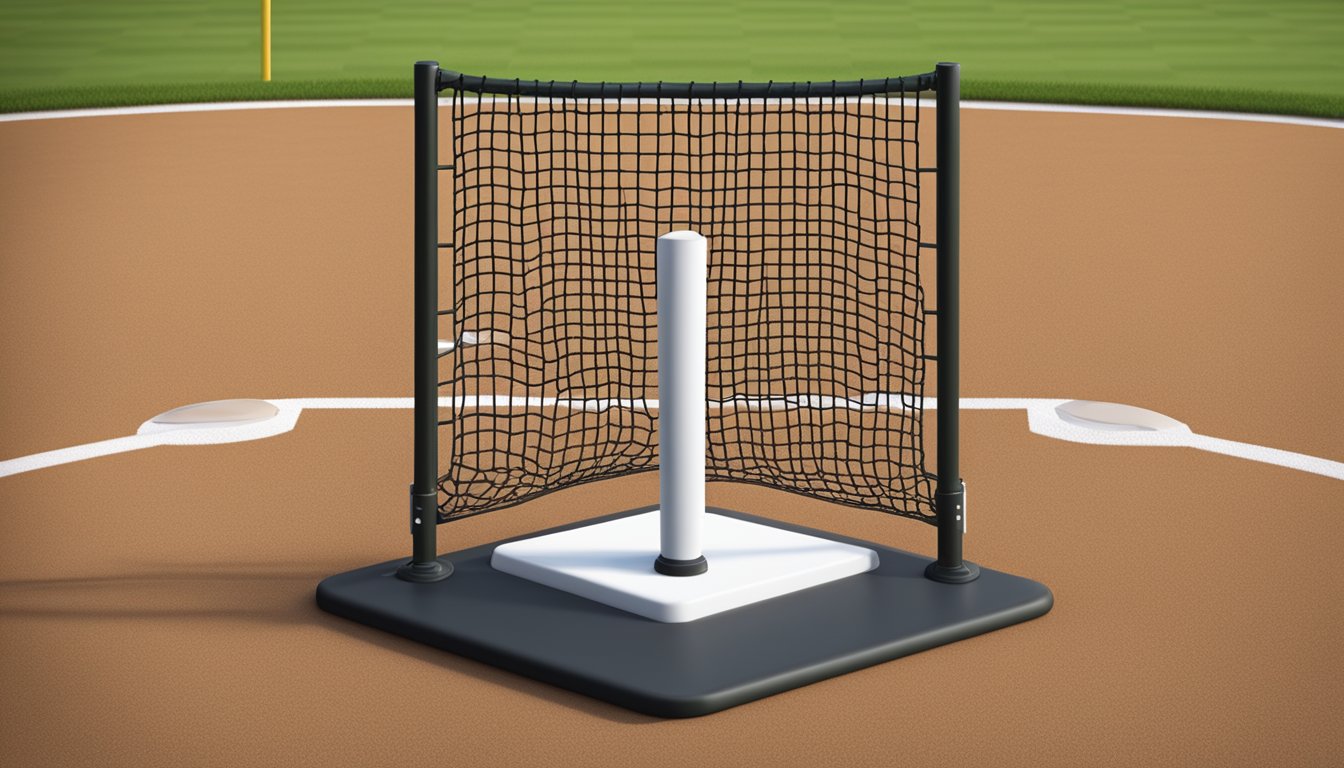For baseball and softball enthusiasts looking to refine their hitting skills, a home batting practice setup can be an excellent investment. By installing a batting tee and practice area at home, players can conveniently work on their swing mechanics, timing, and precision, leading to noticeable improvements in their overall game. The flexibility to train on one’s own schedule allows for more consistent practice, which is essential for developing muscle memory and confidence at the plate.
Setting up a home batting tee system requires a thoughtful approach; it’s not just about purchasing equipment, but also understanding how to use it effectively. Proper assembly, upkeep of the equipment, and employing the right drills are key to making the most out of the training sessions. Additionally, advancements in portable and technological training aids have made it easier than ever for hitters to get real-time feedback and make adjustments on the fly.
Key Takeaways
- A well-designed home batting practice setup can significantly improve hitting skills in baseball and softball.
- Regular, consistent practice with the right equipment and drills is crucial for player development.
- Incorporating technology and ensuring safety are important aspects of an effective and sustainable practice environment.
Understanding the Basics of Batting Practice
https://www.youtube.com/watch?v=VBGjLcNTbLw&embed=true
Batting practice is a critical component of baseball and softball, where the focus lies in improving hitting technique and building muscle memory through repeated drills and reps.
The Role of Hitting in Baseball and Softball
Hitting is a fundamental aspect of both baseball and softball. It requires a combination of physical strength, hand-eye coordination, and mental discipline. A batter’s goal is to effectively strike the pitched ball to achieve a base hit, thereby advancing runners and ultimately scoring runs. The impact of proficient hitters is significant as their ability to consistently produce hits directly correlates to their team’s offensive success.
Essentials of Effective Training
For effective batting training, players need structured drills and a high volume of reps. Key elements of a productive practice include:
- Consistency: Regular training is crucial. Players should adhere to a schedule that allows for frequent and systematic practice sessions.
- Focus: Training should be targeted. Hitters need to concentrate on specific aspects of their swing, from the stance to the follow-through.
- Feedback: Immediate and accurate feedback is vital. This can come from coaches, video analysis, or the audible feedback of the bat-ball collision.
- Progression: Training should evolve with the player’s skill level. As proficiency increases, so should the difficulty of the drills.
Structured practice setups that mimic real game scenarios enable players to translate their skills onto the field effectively.
Designing the Batting Practice Setup
Creating an effective home batting practice setup requires careful consideration of location and attention to space and safety requirements. This will ensure the practice sessions are productive and risk-free.
Selecting the Right Location
When considering the right location, one should evaluate the environment for suitability. Residential areas with limited space might necessitate a compact design. It’s imperative to look for a level area that is free of obstacles. The location should accommodate the size of a standard batting cage, which typically ranges from 70 feet in length to as small as 40 feet for youth players.
Considering Space and Safety
Space and safety are paramount concerns in the setup of a batting practice area. The ideal space should provide ample room for the batter, as well as a safety zone behind and on the sides of the batting cage to protect spectators and property. Here’s a succinct list of safety measures to integrate:
- Netting: High-quality, durable netting to contain errant balls.
- Clearance: At least 10 feet of clearance from fences or walls to prevent ricochets.
- Padding: Padding on poles and edges to minimize injury risks.
- Anchor System: A robust anchor system to secure the cage even in windy conditions.
Choosing Your Equipment
https://www.youtube.com/watch?v=rrtogZdM2o0&embed=true
The essential components of a home batting practice setup are the t base and the batting tee, which need to be both durable and adjustable to accommodate various swing types and player heights. It is also crucial to select the right bats and balls to ensure a productive practice session.
Picking the Right T Base
A stable T base is fundamental for a batting tee. It should be portable yet heavy enough to prevent tipping during practice. Users should look for a T base with a durable construction, such as heavy-duty steel or high-density plastic, to withstand repetitive impact. Adjustable features are a bonus, permitting the tee to be easily transported and stored.
Selecting a Durable Baseball Batting Tee
The longevity of a baseball batting tee hinges on its durability. Look for tees made from reinforced rubber or polyurethane—materials that can take the wear and tear of regular use. An adjustable tee height is indispensable, allowing both baseball and softball players to practice their swing at different ball elevations.
Quality of Bats and Balls
When choosing bats, weight and material are key factors. Bats should be of appropriate weight relative to the player’s size and strength, usually ranging from 15 to 33 ounces. For balls, high-quality leather baseballs and softballs provide the most realistic practice experience. The durability of both bats and balls ultimately dictates their longevity and performance during practice.
Assembly and Maintenance
https://www.youtube.com/watch?v=vBtl0K06RzQ&embed=true
A well-constructed home batting practice setup requires careful assembly and routine maintenance to ensure both safety and longevity. Using high-quality materials and following precise assembly instructions are critical. Regular checks and upkeep of the setup prolong its durability.
Setting Up Your Batting Practice Equipment
The initial assembly of batting practice equipment is straightforward but must be handled with attention to detail. Assemble poles and cables as per the manufacturer’s guidelines to ensure they can bear the repetitive impact of batting practice. It is essential to secure all components firmly; a loose fitting can compromise the structure’s integrity. For a batting tee, align the base with the poles correctly before tightening all connections.
- Poles: Ensure they are made of durable materials and firmly planted to withstand force.
- Base: Confirm that it is level and stable to prevent wobbling during use.
- Cables: Inspect to verify that they are free of fraying and are tightly secured.
Routine Maintenance to Ensure Durability
Maintaining a batting practice setup is crucial for both safety and long-term use. Regular inspections should be performed to check for wear and tear on cables, bolts, and any moving parts. The inspection schedule can depend on usage frequency, but a monthly check is a good baseline.
- Weekly: Wipe down all surfaces to remove dirt and debris.
- Monthly: Tighten any loose bolts and inspect cables for signs of stress.
- As needed: Replace parts that show signs of significant wear to maintain the equipment’s safe use.
Using weather-resistant materials where possible will extend the lifespan of outdoor practice setups, but consider additional protective measures like covers to shield against the elements.
Conducting Effective Drills
https://www.youtube.com/watch?v=XCeIlYUAo0k&embed=true
High-quality practice is key for improving batting skills. Repetition and focus on mechanics during drills can significantly enhance a player’s hitting ability.
Designing a Batting Practice Routine
A balanced batting routine should include a series of drills, each focusing on different elements of the swing. It’s beneficial for hitters to start with lower intensity to warm up and gradually build to more complex activities. Here’s a structure for a routine:
- Warm-Up Swings: Begin with 10-15 easy swings focusing on loosening up the body.
- Stance Drills: 15 reps ensuring a balanced and comfortable stance before each swing.
- Contact Point Drills: Perform 20 reps focusing on hitting the ball at the correct contact point.
Each drill segment should be performed with intent, aiming to create muscle memory for the correct movements.
Incorporating Swing Mechanics
Improving swing mechanics demands attention to detail and conscious adjustments. Utilize the following practices to refine batting technique:
- Balance and Posture: Practice swings while maintaining a stable and balanced stance.
- Hand Path: Use drills to create a direct and efficient path for the hands to follow during the swing.
- Follow-Through: Perform 15-20 reps focusing on a complete and controlled follow-through, ensuring power and direction in the swing.
By systematically addressing each element of swing mechanics, players can develop a consistent and powerful hitting technique.
Advantages of Portable Batting Equipment
https://www.youtube.com/watch?v=Qi-DFpsv1Fs&embed=true
Utilizing portable batting equipment for practice allows baseball players to hone their skills without being confined to a single location. This flexibility contributes to more efficient use of training time and can potentially lead to better player development.
Flexibility in Training Environments
Portable batting equipment, such as a baseball net with a collapsible frame, offers players the ability to practice in a variety of environments. They can easily set up their equipment in backyards, parks, or on the diamond itself. This mobility ensures that players aren’t limited by the availability of practice facilities and can continue their training in diverse settings to adapt to different field conditions.
- Variable Surfaces: Practice on grass, dirt, or artificial turf.
- Weather Adaptability: Train indoors or outdoors depending on weather conditions.
Portable Equipment Options
There is a range of portable equipment options available that cater to different aspects of batting practice. The compactness of these tools is a significant benefit, allowing for straightforward transport and quick setup.
- Tee: A crucial tool for perfecting swing mechanics.
- Collapsible Frame: Saves space and can be assembled in minutes.
- Portable Baseball Net: Creates a safe and effective hitting zone.
Players can select from different sizes and materials to match their specific needs and can find options that are both lightweight and durable. Such equipment is essential for players who are serious about improving, as it provides a consistent practice setting where they can work on their batting technique.
Utilizing Technology in Training
https://www.youtube.com/watch?v=kpBzN0MA5Ok&embed=true
Advancements in technology have revolutionized training for hitters, allowing for detailed performance analysis that can be leveraged by both players and coaches to improve batting skills.
Performance Analysis Tools
Performance analysis tools serve as a vital component for hitters to understand and enhance their batting technique. Coaches rely on technology like high-speed cameras and motion sensors to scrutinize a player’s swing mechanics with precision. They can often dissect the swing into multiple stages, providing immediate feedback on areas that require improvement.
High-Speed Cameras: These cameras capture footage at extremely high frame rates, allowing for slow-motion playback. They help in identifying minute details of a hitter’s swing that are not visible to the naked eye.
Key Metrics Captured by High-Speed Cameras:
- Bat speed: How fast the bat moves through the hitting zone.
- Swing path: The direction of the bat’s movement during a swing.
- Contact point: Where on the bat the ball makes contact.
Motion Sensors: Wearable technology like motion sensors can be attached to a hitter’s bat or body. These sensors provide quantitative data on various aspects of the swing, contributing to a more data-driven approach to training.
Data Provided by Motion Sensors May Include:
- Angle of attack: The angle at which the bat approaches the ball.
- Exit velocity: The speed of the ball after being hit by the bat.
- Swing consistency: How similar each swing is to the last, aiming for a repeatable and efficient motion.
Coaches utilize the data from these performance analysis tools to tailor training programs specific to each hitter’s needs. They can make informed decisions on adjustments to batting technique, ensuring that hitters develop a swing that is both powerful and consistent. Hitters themselves grow more self-aware of their batting, often leading to faster improvements and a more systematic approach to training.
Safety Precautions and Recommendations
When setting up a home batting practice area, safety should be the top priority. Adhering to specific precautions minimizes risks for the batter and others around the practice space.
Personal Protective Equipment (PPE):
- Batter should wear a batting helmet at all times.
- Protective gloves are advised to prevent blisters.
Equipment and Setup:
- Ensure the batting tee is stable and appropriate for the batter’s height.
- Regularly inspect equipment for damage or wear and tear.
Surrounding Area:
- Choose an open area where missed balls cannot cause damage or injury.
- Maintain a safe distance between the batter and bystanders or property.
Practice Protocol:
- Balls should be hit into a net or backstop to contain them.
- Only one person should be in the batting area at a time.
First Aid:
- Keep a first aid kit nearby for any immediate minor injuries.
Instruction and Guidance:
- Beginner batters should receive guidance from an experienced person to ensure proper form and technique.
Frequently Asked Questions
https://www.youtube.com/watch?v=vsQmn6s5ALw&embed=true
Setting up a batting practice space at home requires the right equipment and understanding the use of each component for effective training.
What equipment is necessary for an effective home batting practice setup?
For an effective home batting practice setup, an individual needs a batting tee, a selection of baseballs or softballs, a bat that suits their size and strength, protective netting to absorb missed balls, and enough space to mimic a batter’s box.
How should the batting tee be positioned for optimal swing practice?
The batting tee should be positioned so that the ball sits at the same height as the batter’s waist or slightly lower. The tee should align with the front foot for practicing hitting to different field parts and be placed at varying distances from the home plate to work on inside and outside pitches.
What are some drills to perform while using a batting tee at home?
Drills to perform with a batting tee include practicing swings at different ball heights and positions, working on inside and outside pitches, focusing on driving the ball up the middle, and exercises that improve hand-eye coordination and swing path consistency.
Are there differences between a standard batting tee and a Tanner Tee?
Yes, a standard batting tee is typically a single piece of equipment made from hard rubber or plastic. A Tanner Tee features an adjustable stem and a flexible rubber top that allows for a more realistic feel of hitting a ball and reduces resistance upon contact.
Can you suggest methods to simulate game situations during batting practice at home?
To simulate game situations, batters can incorporate a pitch count into their practice, imagine specific in-game scenarios before hitting, set targets to practice hitting for accuracy, and use varying ball types, such as weighted balls, to develop strength and adaptability.
Do professional baseball players incorporate batting tees into their training regimen?
Professional baseball players regularly incorporate batting tees into their training regimen to fine-tune their swing mechanics, improve their hand-eye coordination, and maintain consistent contact points. It is a foundational training tool at all levels of play.










